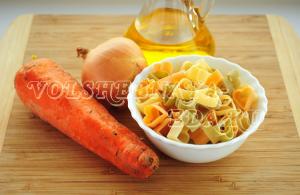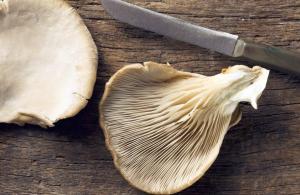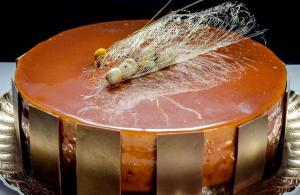Adjapsandali (or ajapsandal) in Georgian is an incredibly aromatic vegetable dish with spices and herbs. It can be eaten as a hot stew, or served as a spicy cold appetizer.
Products for ajapsandali
The basis of the dish is vegetables: eggplant, tomatoes, carrots, onions, garlic and sweet peppers.
Vegetables must be ripe and juicy, as their condition directly affects the taste of the dish
In addition to the vegetable component, greens are used - basil, parsley and cilantro.
Greens must be fresh; dried ones will not give the desired aroma and taste.
And of course, as in all Georgian dishes, spices play the first violin in the symphony of taste. Their set varies depending on the region of the country, but the classic recipe includes black pepper, saffron, coriander and utskho-suneli.
Saffron is the most expensive spice, it is also called “red gold”, but it is what gives Georgian dishes a unique aroma and taste.
The result is a bright and very tasty dish, which is served with fresh bread or pita bread.
Fresh bread is served with the dish in order to collect the delicious sauce in its crumbs
Classic recipe from Tinatin Mzhavanadze
A little advice: try to prepare everything in advance. Wash and chop vegetables, provide free space on the work table. In this case, it will take less time and effort to prepare a flavorful dish.
Ingredients:
- 4 tomatoes;
- 3 onions;
- 4 sweet peppers;
- 3 carrots;
- 4 eggplants;
- 6 cloves of garlic;
- 50 g each of basil, cilantro and parsley;
- 1 tsp. sea salt;
- 1/3 tsp. black pepper;
- 1/3 tsp. utskho-suneli;
- 1/4 tsp. ground coriander;
- a pinch of saffron;
- 5 tbsp. l. vegetable oil.
Step by step recipe:
- Cut the eggplants into slices.
Cut the blue ones into circles 1–1.5 cm thick
- Sprinkle them with a pinch of salt and leave them in the bowl for 30-40 minutes to remove the bitter taste.
Salt will draw out the bitterness from vegetables and make them tender.
- Then fry the eggplants on both sides in a frying pan with hot oil.
Eggplants need to be fried until golden brown.
- Remove seeds from sweet peppers and cut into half circles.
Choose juicy and fresh peppers, the richness of the sauce depends on this
- Peel the onion and chop.
Do not cut the onion too finely; it should be noticeable in the finished dish.
- Peel the carrots and cut into thin strips.
To thinly slice carrots you will need a sharp knife.
- Now you need to fry the carrots and onions until golden.
Do not let the vegetables burn, otherwise the ajapsandali will have an unpleasant aftertaste.
- Chop the greens.
Try not to chop the greens too finely
- Make cross-shaped cuts on the tomatoes and scald them with boiling water.
Tomatoes with cuts are easier to peel
- Let the scalded tomatoes cool slightly and remove the skins.
Processing with boiling water does not harm the taste of tomatoes
- Then chop the tomatoes and place them in the blender bowl. Grind until puree.
You can cut tomatoes arbitrarily, remembering to remove the hard core
- Place all the vegetables in a saucepan, pour in tomato puree, add spices and herbs. Bring ajapsandali to a boil over low heat, stirring all the time.
It is better to take fresh garlic, this will give the dish a sharp, tantalizing aroma.
- Garlic cloves must be ground in a mortar with a pinch of salt until they form a paste. Then add the ajapsandali to the pan, cover with a lid, turn off the heat and let stand for 5-7 minutes.
When laying ajapsandali on plates, try to distribute the sauce and vegetables equally into each plate.
Video: ajapsandal with potatoes
This year we grew a record number of sweet peppers and eggplants at our dacha. So I was racking my brains about what to cook from them. Winter preserves, peppers stuffed in various ways, eggplant caviar - I tried all the recipes, and the vegetables sang and sang. Then I remembered about ajapsandals. Everyone liked the spicy, fragrant dish with Georgian flavor. I served it with homemade bread and a fresh vegetable salad. The most amazing thing is that we ate this dish at least three times a week, but no one complained about the monotony. Indeed, by varying the amount and composition of spices, you can add new flavor accents each time.
Georgian vegetable dishes can surprise you with their rich taste. The thing is that spices give familiar products a bright aroma. At the same time, it is important that in summer and autumn ajapsandali is a very affordable dish, because it does not contain expensive ingredients.
Caucasian, Balkan, and Middle Eastern peoples have many dishes that are prepared from a whole range of vegetables and herbs: eggplant, tomatoes, bell peppers, onions, beans, basil, rosemary, etc. Sometimes potatoes and green beans are added to dishes. This vegetable dish is called differently everywhere: ajapsandal, imambayadi, etc. We are used to calling such dishes the simple word “stew.”
In southern countries, any housewife knows how to prepare ajapsandal. This dish becomes the main meal in the summer and allows the body to accumulate a supply of vitamins for the coming winter. In addition, it is easily digestible and low in calories. In this article we will tell you how to properly prepare ajapsandal.
Vitaminized thick soup
With the arrival of summer, when fresh vegetables appear in vegetable markets, you want to give up all meat and eat exclusively plant foods. It is our body, hungry for fresh vegetables, that demands its own. And so, having bought eggplants, peppers, tomatoes and herbs at the market, we go home to cook something tasty and light. Despite the fact that in our latitudes it is not customary to cook eastern ajapsandal, Russian housewives, having once tasted this tasty dish, begin to ask how to cook ajapsandal. Having learned about the simplicity of the recipe, they immediately begin preparing this thick soup full of vitamins.
Classic recipe (Georgian)

Today there are many options for preparing this southern dish. Each of the peoples made their own adjustments to the original recipe. Some people prepare it thin, others, on the contrary, very thick. Some people add potatoes, and many add green beans or carrots and even cabbage. The classic recipe for this dish consists of the following ingredients:
- eggplants - 4 pieces;
- tomatoes - 1 kilogram;
- red and green bell peppers - half a kilogram;
- large onion - 2-3 heads;
- garlic - 3-4 cloves;
- 1 bunch of greens, consisting of basil, parsley, cilantro, rosemary, etc.;
- spices;
- vegetable or butter.
Now you will learn how to prepare ajapsandal.

Step by step recipe
- Peel the eggplants, cut into cubes with a sharp knife, add salt and set aside.
- Remove seeds and stems from the pepper and cut into strips.
- Place the tomatoes in boiling water and then in cold water to make it easier to remove the skin. Cut into rings.
- Peel the onions and garlic. Cut the onion into thin half rings, and finely chop the garlic.
- Rinse the greens thoroughly in water. Then dry and finely chop.
- Squeeze the eggplants a handful at a time to release the bitterness.
- Take a large saucepan with a thick bottom and place vegetables in it in layers: eggplants, peppers, onions, garlic and tomatoes, herbs, etc. Leave some greens for serving.
- Season the vegetables with black and red pepper.
- Pour in half a glass of vegetable (sunflower or corn) oil. Place ajapsandal on low heat. Cook until it turns out
- At the end, taste the dish and add salt if necessary.
So you know how to cook ajapsandal according to the classic recipe. It is served in deep ceramic bowls, generously sprinkled with herbs.
Meat ajapsandal
In Armenia, this dish is prepared according to two recipes. One of them is classic vegetarian, the second is meat. Surely, you are interested in how to cook ajapsandal with meat according to the Armenian recipe. After all, some men cannot be forced to eat dishes that do not contain this product. According to it, it turns out not as thick as in the previous recipe, but more satisfying and tasty. We present to your attention a list of ingredients, as well as instructions on how to prepare ajapsandal in Armenian.
Products you need

In order to prepare a dish according to this recipe, you need to have:
- Fatty meat with bones: either beef or lamb - about 1 kg.
- Eggplants - 3 pcs.
- Tomatoes - 4-5 pcs.
- Red, yellow and green bell peppers - two of each color.
- 1 capsicum hot pepper.
- Large potatoes - 4-5 tubers.
- Red onions - 2-3 pieces.
- Basil and rosemary - half a bunch (dried herbs can be used).
- Bay leaf - 2-3 pcs.
- A pinch of black pepper.
- Ghee - 1-2 tablespoons.
Cooking method
And now we will tell you how to cook ajapsandal in Armenian.
- The meat should be cut into medium-sized pieces and rinsed thoroughly under water.
- Place two spoons on the bottom of the pan and put it on the fire.
- Peel the onion, chop finely, put in a pan and fry in oil until golden.
- Add pieces of meat to the onion, mix, pepper and cover with a lid. Reduce heat and leave the meat to simmer with onions.
- After 5-7 minutes, pour boiled water to the middle of the walls of the pan. Let the broth simmer for another 10 minutes.
- While the broth is cooking, peel the eggplants and cut into cubes.
- Also prepare the pepper by chopping it into half rings.
- Peel the tomatoes using the method described in the previous recipe and cut into slices.
- Chop the peeled potatoes into the same cubes as the eggplants.
- Finely chop the greens.
- Gradually add eggplants to the broth, then peppers, potatoes - and at the very end, tomatoes. Ten minutes before it’s ready, add the bay leaf and herbs, leaving a little for sprinkling before serving.
As you noticed, potatoes are added in the Armenian version. Therefore, our men will like this recipe more, since it contains both meat and our favorite. Thus, you have learned how to cook ajapsandal with potatoes. By the way, Armenian housewives sometimes add green beans to this dish, which gives it an original taste.

Conclusion
Adjapsandal, regardless of whether it was cooked with meat or not, is a very tasty and healthy dish. Anyone who has tried it at least once in their life will not refuse to taste oriental food again. The recipes we have given, as you noticed, are quite simple, everyone can easily prepare them.
- Flatbread a la FOCACCIA WITH PESTO. Recipe with photos and videos
Flatbread a la focaccia with basil will serve as an excellent addition to soup or main course as bread. And this is a completely independent delicious pastry, similar to pizza.
- Delicious vitamin-rich raw beet salad with nuts. Raw beet salad. Recipe with photos and videos
Try this wonderful vitamin salad made from raw beets with carrots and nuts. It is ideal for winter and early spring, when fresh vegetables are so scarce!
- Tarte Tatin with apples. Vegan (lenten) pie with apples on shortcrust pastry. Recipe with photos and videos
Tarte Tatin or upside-down pie is one of my favorite recipes. This is a chic French pie with apples and caramel on shortcrust pastry. By the way, it looks very impressive and will successfully decorate your holiday table. The ingredients are the simplest and most affordable! The pie does not contain eggs or milk, it is a Lenten recipe. And the taste is great!
- Vegan soup! “Fish” soup without fish. Lenten recipe with photos and videos
Today we have a recipe for an unusual vegan soup - fish soup without fish. For me this is just a delicious dish. But many say that it really looks like fish soup.
- Creamy pumpkin and apple soup with rice. Recipe with PHOTO AND VIDEO
I suggest you prepare an unusual creamy soup from baked pumpkin with apples. Yes, yes, exactly soup with apples! At first glance, this combination seems strange, but in fact it turns out very tasty. This year I grew portioned pumpkins of the variety...
- Ravioli with greens is a hybrid of ravioli and Uzbek kuk chuchvara. Recipe with photos and videos
Cooking vegan (lenten) ravioli with herbs. My daughter called this dish Travioli - after all, the filling contains grass :) Initially, I was inspired by the recipe for Uzbek dumplings with herbs kuk chuchvara, but I decided to modify the recipe in the direction of speeding it up. Making dumplings takes too long, but cutting out ravioli is much faster!
I offer you a recipe for Zebra manna pie without eggs and milk. This is a completely vegan (lenten) baked product. The peculiarity of this manna is that it has layers of different colors, like the stripes of a zebra. Regular dough alternates with chocolate dough, creating a pleasant combination of flavors and an impressive appearance.
Ajapsandal, or ajapsandali, is a traditional dish of Caucasian cuisine, made from vegetables: eggplants, sweet peppers, tomatoes, onions, garlic and herbs (cilantro, basil and others). The vegetables are sautéed or baked and then mixed together. Variations of this dish exist among almost all nations; in Europe, ratatouille is an analogue of ajapsandal. It is distinguished from the usual vegetable stew by the separate frying of the components, their larger cutting and the unusual oriental notes that cilantro and spices give the dish.
- eggplants – 1 kg;
- carrots – 0.5 kg;
- bell pepper – 0.5 kg;
- onions – 2-3 pcs.;
- garlic – 4-6 cloves;
- tomatoes – 700 g;
- basil, cilantro, parsley - 50 g each;
- ground coriander – ½ tsp;
- Utskho-suneli spice – ½ tsp;
- ground saffron - on the tip of a knife;
- salt, ground pepper - to taste;
- vegetable oil – 0.5 l.
- 1. Wash the eggplants and cut into 1 cm thick slices.

- 2. Place them in a deep bowl, sprinkling the layers with salt, let them stand for 30 minutes to release the bitterness. Then rinse. Alternatively, the eggplants can be soaked in salt water while weighing them down.

- 3. Pour vegetable oil into a frying pan, heat it, fry the eggplants until browned, laying out the mugs in 1 layer. After frying, place them on paper towels or drain excess oil through a colander.

- 4. Wash the bell pepper, remove the core and seeds, and cut into strips.

- 5. Fry the peppers in oil over medium heat for 7-10 minutes. until softened.

- 6. Wash the onion, peel and chop into half rings.

- 7. Peel the carrots and cut into strips.

- 8. Pour more oil into the pan and fry the onions and carrots, salting them a little. Simmer over low heat for 20 minutes. until the vegetables soften.

- 9. Wash the greens and finely chop them with a knife. Fry with a little oil for 3-5 minutes.

- 10. Wash the tomatoes and prepare puree: grate on a coarse grater, discard the skin.

- 11. Place all cooked vegetables, herbs, and spices in a thick-bottomed saucepan or saucepan and simmer over low heat for 15 minutes. Add salt if necessary. Turn off the fire. Let the vegetables brew under the lid. Serve ajapsandal hot or as a cold salad.

- eggplant – 1 pc.;
- tomatoes – 2 pcs.;
- red sweet pepper – 1 pc.;
- onion – 1 pc.;
- garlic – 2 cloves;
- apple cider vinegar – 1 tbsp. l.;
- cilantro, basil and other greens - a few sprigs for decoration;
- salt, pepper - to taste.
- 1. Turn on the oven and heat it to 250 degrees. Turn on the grill's top airflow (if equipped).
- 2. Wash the eggplants, tomatoes, peppers and dry them. Remove the stems of the eggplants and remove the seeds from the sweet peppers. Cut vegetables into 2 halves.
- 3. Place the vegetables on a baking sheet and place in the oven for 20 minutes.
- 4. Cut the onion into half rings, chop the herbs and garlic.
- 5. Remove the vegetables from the oven, place in a deep bowl and cover. Leave them for a while so that the skins come off better.
- 6. Peel the vegetables, cut the eggplants into cubes, small tomatoes into halves, large ones into several parts, peppers into strips.
- 7. Add herbs, garlic, spices. Sprinkle the dish with apple cider vinegar.
- eggplants – 2 pcs. medium size;
- tomatoes – 3 pcs.;
- red sweet pepper – 2-3 pcs.;
- onions – 2 pcs.;
- garlic – 3 pcs.;
- vegetable oil – 200 ml;
- cilantro, parsley, dill - to taste;
- salt, spices, hot pepper - to taste.
- 1. Prepare vegetables as described in the classic step-by-step recipe.
- 2. Set the “Fry” mode in the multicooker and fry the eggplants for 2-3 minutes. on each side in vegetable oil. It will take several steps since all the eggplants will not fit in the bowl.
- 3. Cut the tomatoes into cubes, onions into half rings, and pepper into rings. Chop the garlic and herbs.
- 4. Place the eggplants in a bowl, add the rest of the vegetables, salt, spices and herbs. Place in a slow cooker.
- 5. Set the “Stew” mode and hold for 1 hour. If little juice has been released from the vegetables, stir them so that they do not burn.
- 6. Place ajapsandali on a plate and garnish with herbs.
- lamb (or pork) – 500 g;
- onion – 1 pc.;
- tomatoes – 4 pcs.;
- bell pepper – 3 pcs.;
- potatoes – 3 pcs.;
- eggplants – 2 pcs.;
- butter – 50 g;
- vegetable oil – 30 g;
- dried basil – 3 pinches;
- bay leaf – 2 pcs.;
- salt, ground black pepper, coriander - to taste.
- 1. Cut the meat into medium-sized cubes.
- 2. Melt butter in a cauldron or deep frying pan, add vegetable oil.
- 3. Place the meat in the oil. Fry it over high heat until a crust appears, stirring occasionally. Then pour 100 ml of water and reduce heat. Simmer the lamb until done.
- 4. Wash and peel the potatoes and tomatoes, cut them into medium-sized pieces.
- 5. Cut the onion into half rings.
- 6. Peel the bell pepper and cut into strips.
- 7. Wash the eggplants, remove the stems, cut into rings or half rings, sprinkle them with salt, leave for 15-20 minutes.
- 8. Place eggplants and onions in a cauldron, cover with a lid, and simmer with meat for 10 minutes.
- 9. Add chopped potatoes, salt, cook for another 10 minutes.
- 10. Add sweet peppers and tomatoes. Add water if necessary to prevent the meat from burning. Add basil. Simmer for 25 minutes.
- 11. Add bay leaf, spices, mix all layers and keep on fire for another 10 minutes.
- 12. Turn off the gas and let it brew under the lid closed for 15 minutes. Serve, garnish with sprigs of parsley, basil or chopped herbs.
- tomatoes, eggplants, sweet bell peppers, onions - according to the number of guests present;
- garlic – 3 cloves;
- vegetable oil – 3-4 tbsp. l.;
- greens (parsley, cilantro, basil) – 100 g;
- ground pepper, salt - to taste.
- 1. Light the coals in the grill and get them hot.
- 2. While the grill is being prepared, wash the vegetables and remove the stems.
- 3. Place whole vegetables on skewers and bake them over coals (or over an open fire).
- 4. After baking, place the vegetables in cold water. Peel them.
- 5. Cut the vegetables into cubes.
- 6. Prepare a sauce from chopped garlic, vegetable oil, salt, spices and chopped herbs. Mix them.
- 7. Place peppers, eggplants, onions and tomatoes on a common dish, add salt and pepper and pour over the sauce.
- eggplants – 2 pcs.;
- khmeli-suneli seasoning, ground pepper, salt - to taste;
- bell pepper – 2 pcs.;
- tomatoes – 8 pcs.;
- zucchini – 2 pcs.;
- potatoes – 4 pcs.;
- garlic – 5 cloves;
- onions – 2 pcs.;
- carrots – 1 pc.;
- greens (parsley, dill, cilantro, basil) - to taste;
- vegetable oil – 4 tbsp. l.;
- dried cumin – 1 pinch;
- hot capsicum – 1 pc.
- 1. Light a fire and place a grate on the fire. Place a cauldron and heat it well. Add vegetable oil to the cauldron.
- 2. Wash the vegetables. Remove the stem from the eggplants, cut them into cubes, soak them in salted water as in the first recipe, then rinse.
- 3. Wash, peel and cut potatoes, sweet peppers and carrots into cubes.
- 4. Wash the young zucchini and cut it with the skin.
- 5. Cut the onion into half rings.
- 6. Peel and chop the garlic.
- 7. Make a cross-shaped cut on the tomatoes, pour boiling water over them and remove the skin.
- 8. Place onion in a cauldron and fry it.
- 9. Add chopped potatoes, salt and pepper, fry them with caraway seeds for 5 minutes.
- 10. Add sweet peppers and fry for 5 minutes.
- 11. Add eggplants.
- 12. After they are fried, turn off the fire and continue cooking over coals.
- 13. Add water to the middle of the vegetables, close the lid and simmer until the potatoes soften.
- 14. Cut the zucchini and tomatoes into cubes, chop the herbs and garlic.
- 15. Place them together with hot peppers in a cauldron and simmer for 10 minutes.
- eggplants – 800 g;
- bell pepper – 6 pcs.;
- onion – 500 g;
- young zucchini – 300 g;
- carrots – 5 pcs.;
- sunflower oil – 500 ml;
- sugar – ½ tbsp. l.;
- tomato paste – 200 g;
- garlic – 1 head;
- hot peppercorns – 5 g;
- coriander seeds – 3 g;
- 6% vinegar – 100 ml.
- 1. Wash the eggplants, remove the stems, cut into 1x1 cm cubes and soak for 20-30 minutes. in salted water.
- 2. Wash, peel and cut carrots and zucchini into cubes. You can also grate carrots.
- 3. Mix tomato paste with 100 ml of water.
- 4. Place all ingredients and spices in a deep saucepan and simmer for 35 minutes.
- 5. Steam sterilize glass jars.
- 6. Pour ajapsandali into jars and roll up the lids.
- 7. Place them in a preheated oven on a baking sheet, metal lids down, and sterilize for another 30 minutes. Store the workpiece at a temperature no higher than +3 degrees.
- Real ajapsandal should consist of large pieces of chopped vegetables, otherwise the dish is more reminiscent of stew, vegetable caviar or salad. When slicing, you should strive to make pieces of the same size so that there is no shift in flavor emphasis in favor of large components.
- Before baking, it is recommended to make lattice-shaped cuts on the eggplant slices. Thanks to this, the vegetable will bake better.
- All ingredients of ajapsandal must be brought to full readiness when frying. Crispy peppers or half-raw eggplants will ruin the delicate texture of the dish.
- Onions and carrots should be stewed in a large amount of oil, since with this method of cooking they are not fried, but simmered in their own juice. Thanks to this, the dish turns out tasty and juicy. Excess oil can be drained after frying. After this treatment, onions do not lose their color and do not burn.
- It is recommended to use rubber gloves when cutting hot peppers. It is better to remove its seeds, since all the pungency is concentrated in them.
- To prevent the garlic from darkening, it is ground with coarse salt.
- Salt is added at the end of cooking.
- To prevent the main ingredients from overcooking, potatoes are placed in the ajapsandal.
Show all
Classic recipe
Ingredients:
Preparation:
The classic recipe for preparing a dish in Georgian cuisine involves using only vegetables. To obtain a denser consistency, add potatoes.
In Armenia, ajapsandal is always cooked with meat. To make the dish spicier, add hot peppers, cut into slices, into the pan. The cooking time is 1.5 hours, the most labor-intensive part is frying the vegetables.
Dietary recipe (in the oven)

Ingredients:
Preparation:
The preparation time for ajapsandal according to this recipe is 40 minutes. Due to the fact that there is no frying, it is dietary and less caloric. If you let ajapsandal stand for a day in the refrigerator, it will acquire a richer taste. Cooked vegetables are served as an independent dish and as a side dish for meat.
In a slow cooker

Ingredients:
Preparation:
With meat

Ingredients:
Preparation:
Cooking time is 1.5 hours. Fatty meat can be used for this recipe. In this case, it is necessary to reduce the amount of vegetable oil and butter, since the lard will melt during the cooking process. The meat is pre-beaten to make it softer and juicier.
On the grill

Ingredients:
Preparation:
Since the vegetables are cooked entirely on the grill, ajapsandal turns out to be especially tasty and juicy. It can be served with barbecue or wrapped in pita bread.
On the fire in a cauldron

Ingredients:
Preparation:
Preparation for the winter

Ingredients:
Preparation:
The taste of such a salad for the winter will differ from the traditional dish of Georgian cuisine, since vinegar is used for canning. Its preparation time is 1.5 hours.
Secrets of experienced chefs
There are some tricks when preparing the dish:
Experienced chefs believe that the highlight of the dish lies in the combination of eggplant and cilantro, so do not neglect this spicy herb. Also, do not simmer ajapsandal for too long. 15 minutes is enough. over low heat, otherwise the dish will boil too much and lose flavor.
What could be better than a vegetable dish in summer? What if it’s aromatic and Georgian? :) I live in Georgia and tried a lot of Ajapsandali recipes (that’s what it’s called in Georgian) until I came to this one. It has become an integral dish in our family. A mixture of herbs gives the dish a unique aroma and bright taste.
Required ingredients.
First you need to peel the eggplants and cut them into large circles, about a centimeter wide.

Pour cold salted water over the eggplants and place a weight on top for 20-30 minutes so that all the bitterness comes out of them.

Peel the potatoes, cut them into small pieces and cook over medium heat.

Meanwhile, the eggplants have already soaked, pour out the juice and squeeze them well. Heat a frying pan very hot, pour a lot of sunflower oil onto it, since eggplants tend to absorb a lot of oil. Wait until the oil heats up and place the eggplant slices tightly next to each other.

While the potatoes are boiling and the eggplants are frying, peel the onions, bell peppers and hot capsicums.

Cut the onion into cubes, bell pepper into half rings, and capsicum into slices.

Place the eggplants in batches, as many as fit in the pan at a time. After they are fried, place them in a colander to drain off all excess oil.

Meanwhile, the potatoes are almost cooked (you need to undercook them a little), take them out with a slotted spoon and leave to cool.

We cut the washed tomatoes in half, cutting off the remaining tails, and grate them until they peel.
Usually in these cases they say to scald the tomatoes with boiling water, peel them and cut them into cubes or then grate them, but in my opinion my method is simpler, isn’t it? :)

When all the eggplants are fried, add potatoes, cut into 1-1.5 cm cubes, into the same frying pan in which they were fried. Fry until golden brown.

Place the fried potatoes temporarily in a bowl and add peppers and onions to the pan. Fry until the onion is golden. Then add back the potatoes and eggplants. Pour in grated tomatoes. If your tomatoes are not juicy enough, you can add a tablespoon of tomato paste and a little boiling water. Simmer for 5 minutes, stirring gently.

Chop the greens and garlic. I prefer finely chopped garlic, but you can put it through a press. I have dried thyme, it is usually used in Georgian cuisine when preparing Lobio. Pour the greens and garlic into the pan and simmer for another 5 minutes, stirring carefully.

Ajapsandali is ready, you can serve it to the table, bon appetit!

In Georgia, it is the main dish and is eaten without a side dish, as it is quite filling, but pasta and even mashed potatoes go perfectly with it, despite the fact that Adjapsandali itself contains potatoes. They usually eat it cold, but I prefer it warm.









